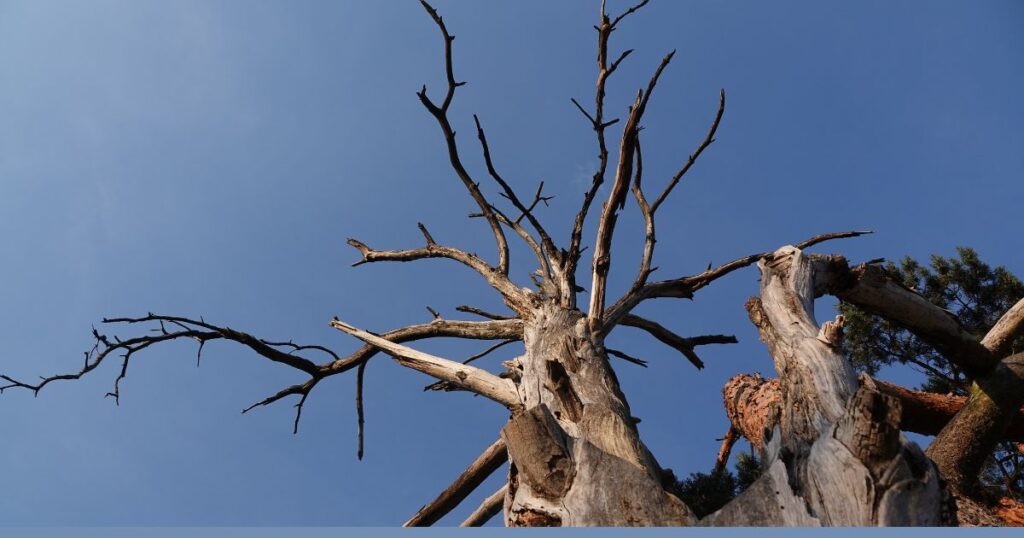Tree removal services should be a priority when dealing with dead, diseased, or dying trees on your property. Dead, diseased, or dying trees on your property should be removed as soon as possible. These trees can be dangerous because branches or the entire tree could fall, causing damage or injury.
Reasons for Tree Removal
Tree removal is often needed to keep your property safe, functional, and looking good. Here are some common reasons why homeowners and property managers might choose to remove a tree:
- Dead or dying trees
- Property damage
- Obstruction to construction or landscaping
Let’s look at each of these reasons before explaining what to expect and how to care for your property afterward.
1. Dead or Dying Trees
Unhealthy trees can be a big risk to your property and safety. Dead trees are weak and can easily break or fall, causing damage to homes, vehicles, and possibly injuring people.
As dead trees decay, they become even weaker and more dangerous, especially during strong winds or storms. Removing dead or dying trees quickly can prevent these hazards and keep your environment safe.
2. Property Damage
Tree roots can cause serious damage to underground utilities like plumbing and sewage lines, as well as building foundations. Over time, roots can block pipes, leading to costly repairs and water damage. Additionally, branches can touch roofs, siding, and power lines, leading to physical damage and increasing the risk of power outages and fires. Removing trees that threaten your property’s infrastructure can prevent these problems and save you from expensive repair bills.
3. Obstruction to Construction, Landscaping, and Pool Installations
Sometimes, trees need to be removed to make room for new construction or landscaping projects. Whether you’re planning to add to your home, install a new driveway, redesign your garden, or install a pool or fence, certain trees might be in the way.
Removing these trees allows you to better use your property and can improve its appearance and function. Strategic tree removal can also improve sunlight exposure and soil conditions for the remaining plants, leading to a healthier and more attractive landscape.

What to Expect During the Tree Removal Process
The tree removal process generally involves two key steps where your involvement is important:
1. Initial Consultation and Assessment: A professional will examine the tree’s condition, size, and location. They will discuss your options and create a plan for safe removal.
2. Obtaining Necessary Permits: Depending on where you live, you might need permits for tree removal. Forestwood Tree Service can assist with this process to ensure you follow local by-laws and can even handle the permit applications for you.
Finding a tree removal company that is both trustworthy and within your budget can sometimes be challenging. Be sure to read reviews, check their website for testimonials and case studies, and always confirm that they are licensed and have liability insurance. This protects you in case of accidents or damage. Also, remember to ask for a detailed estimate from the tree removal service. The estimate should cover the cost of removal, stump grinding, and cleanup.
After hiring a tree service professional, they will guide you through the steps mentioned above. However, depending on the company, there are a few more things you might need to consider:
- Clear the Area: Remove any objects, furniture, or plants near the tree. This makes the removal process safer and more efficient.
- Notify Your Neighbors: Let your neighbors know about the scheduled removal to prevent any inconvenience or misunderstandings.
- Protect Nearby Structures: Use barriers or covers to shield nearby structures and plants from potential damage during the removal process.
Aftercare and Follow-up
After the tree removal process is complete, proper aftercare and follow-up steps are essential to ensure the health of your landscape and prevent future issues. Here are some important considerations:
Stump Grinding
One of the first decisions to make post-tree removal is whether to remove or grind the stump. Stump grinding is a popular and less invasive option that grinds the stump down to below ground level, leaving the roots intact. This allows for planting of grass / laying sod and prevents new growth. Full removal of the root system for large trees would require full excavation of the yard. Forestwood Tree Service also submits Utility locates at no charge on behalf of the homeowners before digging as required by law and for the safety of all.
Planting New Trees
Maintaining greenery on your property is important for environmental and aesthetic reasons. When selecting new trees to plant, choose species that are well-suited to your local climate and soil conditions. Native species are often the best choice as they are adapted to the local environment and require less maintenance. Planting new trees can provide shade, improve air quality, and enhance the overall appearance of your property. Make sure to plant the new trees in appropriate locations where they have room to grow and won’t interfere with structures or utilities.
Regular Maintenance and Care Tips
To ensure the longevity and health of your new trees and landscape, regular maintenance and care are essential. This includes:
- Pruning: Regularly prune your trees to remove dead or damaged branches and encourage healthy growth. Proper pruning also helps maintain the tree’s shape and prevent potential hazards.
- Watering: Ensure your trees receive adequate water, especially during dry periods. Newly planted trees require more frequent watering to establish strong roots.
- Mulching: Apply mulch around the base of your trees to retain moisture, regulate soil temperature, and suppress weeds.
By following these aftercare steps, you can ensure that your landscape remains healthy and vibrant after tree removal. Proper care and maintenance not only enhance the beauty of your property but also contribute to a sustainable and thriving environment.
Conclusion
Tree removal is a significant task that requires careful planning and execution. By understanding what to expect and how to prepare, you can ensure a safe and efficient process.
For professional and reliable tree removal services in Mississauga, Ontario, contact Forestwood Tree Service for a consultation and let our experts handle your tree care needs. Our team is dedicated to providing high-quality service to ensure the health and safety of your property.


Leave A Comment